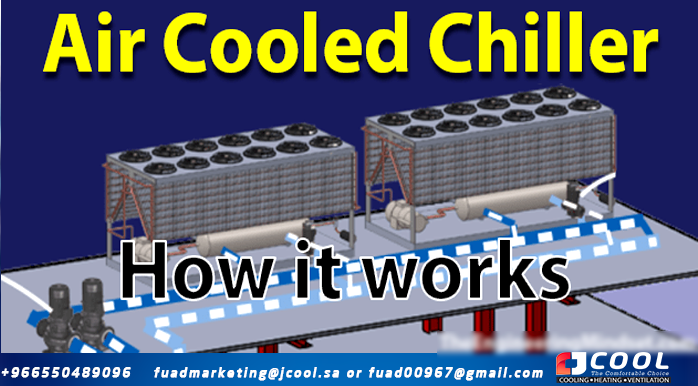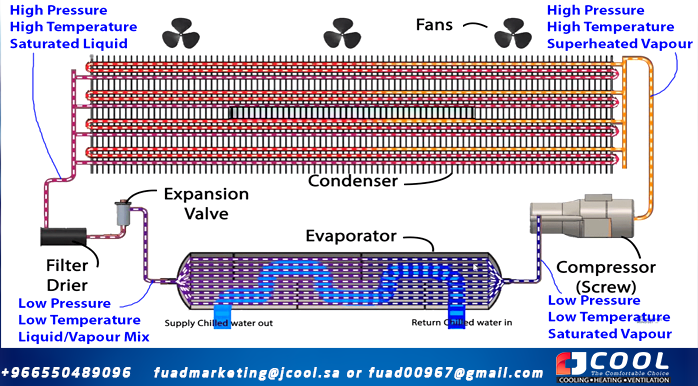Basics of how Air Cooled Chillers work
 |
| How Air Cooled Chillers work |
In this article, we will take a look at how air coolers work. Air-cooled chillers are very common, especially in small to medium-sized office and commercial buildings. They are usually located outdoors, either on the roof or at ground level. This is because air-cooled chillers do not use cooling towers, but instead exhaust their heat into the ambient air, and therefore need access to a large amount of cool air to reject unwanted heat from the building.
Scroll down to see the video tutorial on this topic.
 |
| Air cooler operation - animation |
The chillers will produce "chilled water" which is pumped around the building to air handling units (AHUs) and fan coil units (FCUs) which remove unwanted heat from the building and transfer it to the refrigeration loop. Chilled water will enter the AHU/FCU at approximately 6°C (42.8°F) and by the time it leaves the AHU/FCU heat exchanger it will have reached approximately 12°C (53.6°F) and will return to the air cooler to vent this heat to the atmosphere before repeating the cycle.
The hot “chilled water” return only enters the evaporator through the outer surface of the inner tubes, which contain the refrigerant, and then exits the opposite end having given up its thermal energy. Coolant is the only fluid that moves around each of the cooler components. It changes its pressure, temperature, enthalpy, and input as it moves through the machine and removes unwanted heat from the chilled water in the evaporator.
The air cooler has 5 main components.
1. The compressor, generally screw, scroll or reciprocating.
2. The condenser: a set of horizontal pipes that contain the hot refrigerant, surrounded by a series of thin metal sheets on the vertical axis. These help distribute heat away from the tubes and into the air that is blown through the tubes and thin sheets of metal.
3. Condenser Fans – Draw air through the condenser coils, enter the sides, and then force that air through the top of the unit and into the ambient atmosphere.
4. Expansion valve: expands the refrigerant before it enters the evaporator
5. Evaporator – This is where the chilled water is produced and heat is removed from the hot return “chilled water” and sent to the condenser.
 |
| How refrigerant moves through the cooler |
 |
| How the refrigerant changes around an air-cooled chiller |
The compressor is the driving force of the refrigerant. The refrigerant first leaves the compressor as high-pressure, high-temperature superheated vapor, then enters the condenser.
When the refrigerant enters the condenser, it flows along the horizontal pipes and transfers its heat energy to the ambient airflow that is forced by the fans located on the top.
As the refrigerant transfers its thermal energy, it begins to condense into a liquid. By the time the refrigerant leaves the condenser, it will be a saturated liquid of high pressure and medium temperature.
Then the refrigerant enters the expansion valve. The expansion valve measures the flow of refrigerant around the system. The most basic type is the thermal expansion valve that controls the flow of refrigerant by measuring the temperature of the pipe at the outlet of the evaporator and will adjust the flow to keep the temperature within the desired set point.
The expansion valve retains the refrigerant and maintains high condenser pressure. Inside the expansion valve, a small hole allows a limited amount of refrigerant to continue to flow. As it flows through this restriction, it reaches the low pressure side of the valve. This sudden drop in pressure allows the refrigerant to expand from a liquid to a liquid/vapor mixture. When this happens, the pressure and temperature drop. It flows the same amount of coolant, it just has more space, so it expands to fill that space.
The refrigerant then enters the evaporator and passes through a series of horizontal tubes that are surrounded by the "chilled water" and these flow in the opposite direction, countercurrent to each other. By the time the refrigerant leaves the evaporator, it will have absorbed unwanted heat from the returning cold water and exit as low-pressure, low-temperature saturated vapor. The chilled water will have given up its thermal energy to the refrigerant and will exit at about 6°C (42.8°F).
Do you need help maintaining
and repairing an air conditioner?
It's hard to keep cool when the air conditioning
isn't working. Whether it's repairs, air conditioning,
regular maintenance, or assistance with choosing
your new unit, JCOOL professionals can keep
you comfortable all year
Jamjoom Cooling Systems Factory (JCOOL)
products (condenser coil - evaporator coil -
heat exchanger- air conditioning -
cold evaporator - cooler -industrial air cooler
- tube bundle - air heat exchanger)
Make a reservation immediately with the
maintenance teambefore the summer heat
intensifies.
Let us help you with a lot of maintenance
and installation work on your next project.
To request the service: -
Jamjoom Cooling Systems Factory
Jeddah - Second Industrial City - Street 49
fuadmarketing@jamjoomarcool.com
fuadmarketing@jcool.sa
Fuad00967@gmail.com
Eng/ Abu Hussam
#heatExchangers #condensers #evaporators
#coolers #coils #airDucts #chiller's #jcool
#Saudi_industry #cooling #ventilation
#radiators #jcool #jamjoomCoil #jamjoom_cooling_systems_factory
#jamjoom #saudiArabai #coolingtowers #cooling_tower #coolingcoils
#heat_exchanger #heatexchanger #coolingsystems #cooling #chiller
#hvac #jamjoom_hvac #jamjoom_cooling #global_cooling_tower
#Brand_Saudi_Arabia #made_in_Saudi_Arabia #🇸🇦
- TAGS
- #air #
- building_services
- #chiller
- #compressor
- #condenser
- #cooled
- #Enthalpy #
- Entropy
- #evaporator
- #expansion_valve
- #how
- #HVAC
- #it
- #works #jcool #jamjoomCoil #jamjoom_cooling_systems_factory


Comments
Post a Comment